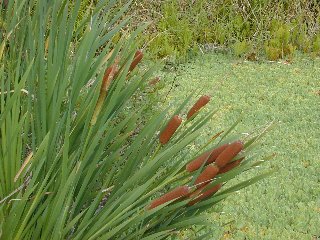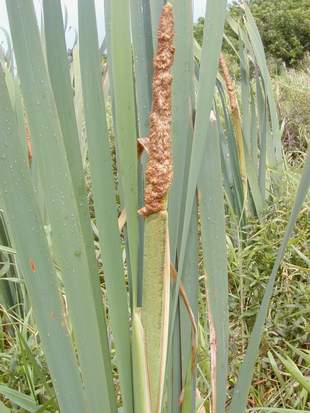|
[FLOWERING PLANTS]
|
|
|
94a
|
(74)
|
Plant generally grass-like: herbaceous, with leaves linear, very many times longer than wide, leaf veins parallel; OR plant a green stem without obvious leaf-like structures, or these small and sessile (leaf lacking a petiole or leaf-stem), clasping the stem. Flower heads may be conspicuous, but individual flowers are small and usually mature to some shade of brown or yellow (usually green when immature)
~ Class LILIOPSIDAE (MONOCOTS, in part)
|
[95]
|
|
|
94b
|
|
Plant not grass-like: may be herbaceous or may be woody, but leaves at most only 5 or 6 times longer than broad; leaf veins arising from a central axis or radiating from a central point. Flowers variable, but many species with conspicuously colored or otherwise showy petals
|
[107]
|
|
|
|
~~~~~~~~~~~~~~~~~~~~~~~~~~~~~
|
|
95a
|
(94)
|
Plant mostly a soft, green, vertical stem (called a culm), without leaves, or leaves present only as basal sheaths without blades, or blades inconspicuous. Flower head or heads (called spikelets) at or near tip of stem, in some cases, with a conspicuous bract subtending (found directly below) the flower head. Rushes
~ Family CYPERACEAE
|
[100]
|
|
|
95b
|
|
Stem, if soft, green, and upright, then clasped by one or more long, narrow leaves or with a basal rosette of narrow leaves; OR stem otherwise (creeping, branching).
|
[96]
|
|
|
|
~~~~~~~~~~~~~~~~~~~~~~~~~~~~~
|
|
96a
|
(95)
|
Leaves in two ranks (distichous; looking down on the culm, leaves come off on two sides). Stems usually hollow except at nodes
|
[97]
|
|
|
96b
|
|
Leaves in three ranks (looking down on the culm, leaves come off on three sides), with closed leaf sheaths. { Stem usually solid, usually trigonous (three-sided). Sedges
~ Family CYPERACEAE |
[105]
|
|
|
|
~~~~~~~~~~~~~~~~~~~~~~~~~~~~~
|
|
97a
|
(96)
|

|
Flowers arranged in a dense, solitary spike (1.5 - 3 cm diameter) arising above flattened, spongy, pale green leaves, lacking a midrib. Cattail
~ Family TYPHACEAE
|
[98]
|
|
|
|
97b
|
|
Flowers arranged in various ways, usually in several to many spikelets. Leaves linear, pale to dark green, but not fleshy or spongy, often with a midrib that is prominent on upper or lower surface. Grasses. A key to all the common grass species found in Hawai‘i and Guam starts at couplet 10 link as no key specific to aquatic grasses has been developed at CPIE.
~ Family POACEAE
|
[10]
|
|
|
Key to Family Typhaceae
|
|
98a
|
(97)
|
Flowers with scales; male flower spike above and separated from female flower spike by an interval of 0.5 to 6 cm. Uncommon
Typha domingensis Pers.
|
|
|
98b
|
|
 |
Male flowers lack scales; female flowers with hairs; male flower spike contiguous above female flower spike, or sometimes separated by an interval of not more than 2.5 cm. Common cattail
Typha latifolia L.
|
|